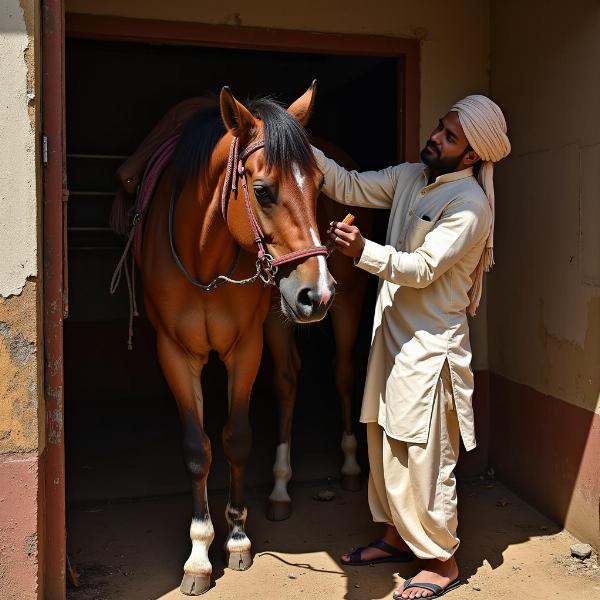Understanding the meaning of “horse stable” in Hindi is more than just finding a direct translation. It delves into the cultural significance of horses in India and the various terms used to describe their housing. This guide will explore the different Hindi words for “horse stable,” their nuances, and related vocabulary. We’ll also discuss the importance of stables in Indian culture and their role in equestrian practices.
Exploring Hindi Words for Horse Stable
Several Hindi words can be used to translate “horse stable,” each with its own subtle connotations. The most common term is अस्तबल (astabal), derived from the Persian word “istabl.” This word encompasses the general meaning of a stable, a building designed to house horses. Another term is घुड़साल (ghursal), which more specifically refers to a place where horses are kept and trained. While both terms can be used interchangeably, ghursal emphasizes the training aspect, often associated with royal stables or those used for competitive riding. Less common, but still used in certain regions, are terms like तबेला (tabela) and पागा (paga). These often refer to smaller, more informal horse shelters, particularly in rural areas.
The Cultural Significance of Stables in India
Historically, horses played a vital role in Indian society, serving in warfare, transportation, and agriculture. Royal families maintained elaborate stables, showcasing their wealth and power. The stables were not just places to house horses; they were symbols of prestige and a testament to the kingdom’s equestrian prowess. Even today, horses hold a special place in Indian culture, particularly in rural communities, where they are essential for farming and transportation.
Understanding Related Vocabulary
Knowing related vocabulary can enrich your understanding of the subject. For example, a साईस (sais) is a groom or stable hand responsible for caring for the horses. A अश्वशाला (ashvashala) is another term for a stable, often used in literary contexts. Learning these terms helps paint a more comprehensive picture of the equestrian world in India. You might also be interested in learning about a घुड़सवार (ghudsawar), a horseman or rider. The care and attention given to horses extends beyond just their housing; it reflects a deep respect for these animals.
What is a Stud Farm in Hindi?
Another relevant term is “stud farm.” In Hindi, it’s called a प्रजनन फार्म (prajanan farm). These farms specialize in breeding horses, focusing on lineage and specific traits. They play a critical role in maintaining and improving horse breeds. stud farm meaning in hindi explains this concept further. Understanding the difference between a regular stable and a stud farm is essential when discussing equestrian practices in India.
Different Types of Stables in India
From simple rural shelters to sophisticated urban facilities, stables in India vary significantly in design and purpose. Traditional stables are often built with locally available materials like mud, wood, and thatch. Modern stables, particularly those used for competitive riding or breeding, incorporate advanced features like climate control, specialized flooring, and individual stalls.
How do I say “He works at the horse stable” in Hindi?
The translation would be “वह अस्तबल में काम करता है” (vah astabal mein kaam karta hai). This simple sentence effectively conveys the meaning, using the common term “astabal” for “horse stable.” aashvik meaning in hindi might help you further understand the nuances of equestrian terminology.
Horse Stable Management in India
Managing a horse stable involves various tasks, including feeding, grooming, cleaning, and providing veterinary care. syce meaning in hindi discusses the role of a syce, highlighting the importance of skilled personnel in stable management. Proper stable management is crucial for ensuring the health and well-being of the horses.
 Horse Grooming in India
Horse Grooming in India
Conclusion: More Than Just a Building
Understanding “horse stable meaning in Hindi” extends beyond a simple translation. It requires exploring the cultural significance of horses in India, the various terms used to describe their housing, and the associated practices. From the traditional अस्तबल (astabal) to the more specialized घुड़साल (ghursal), each term reflects the diverse equestrian landscape of India. Whether you are interested in history, culture, or equestrian practices, exploring this topic provides valuable insights into the rich relationship between humans and horses in India.
FAQ:
- What is the most common Hindi word for “horse stable”? The most common word is अस्तबल (astabal).
- What is the difference between अस्तबल (astabal) and घुड़साल (ghursal)? While both mean “horse stable,” घुड़साल (ghursal) often implies a place where horses are also trained.
- What is a प्रजनन फार्म (prajanan farm)? It is a stud farm, specializing in breeding horses.
- What is the Hindi word for a groom or stable hand? It is साईस (sais).
- Where can I learn more about related terms like “hostler”? You can find more information at hostler meaning in hindi.
- Is there a resource for understanding “stable” in a broader context? Yes, meaning of stable in hindi might be helpful.
- Where can I find translations for other equestrian-related terms? Consider exploring resources like Meaning-Hindi.in for further information.
Meaning-Hindi.in offers professional translation services specializing in various fields, including business, legal, technical, website localization, and educational documents. We pride ourselves on providing accurate and culturally sensitive translations, ensuring your message resonates effectively with your target audience. Whether you need to translate business contracts or educational materials, our team of expert linguists is dedicated to delivering high-quality translations. Contact us today for all your Hindi translation needs at [email protected] or call us at +91 11-4502-7584. Meaning-Hindi.in is your trusted partner for bridging language barriers and connecting cultures.